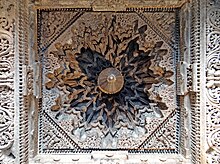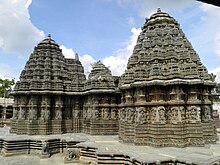
Back Vesara French वेसर शैली Hindi ವೇಸರ Kannada वेसारा शैली Marathi Arquitetura vesara Portuguese Vesara Albanian





Vesara is a hybrid form of Indian temple architecture that combines Dravidian Southern Indian site layouts with shape details characteristic of the Nagara style of North India. This fusion style likely originated in the historic architecture schools of the Dharwad region. It is common in the surviving temples of later Chalukyas and Hoysalas in the Deccan region, particularly Karnataka. According to Indian texts, Vesara Style was popular in central India, particularly in between the Vindhya Range and the Krishna River.[1][2][3] It is one of six major types of Indian temple architecture found in historic texts, the others being Nagara, Dravida, Bhumija, Kalinga, and Varata.[4]
Some scholars like Adam Hardy avoid using the term "Vesara" because although ancient writers used the word, they may have intended different meanings from its modern usage.[5] Alternative terms for the tradition's whole timespan, from the 7th to the 13th century CE, include "Karnata Dravida" (Hardy's choice),[6] "Central Indian temple architecture style", "Deccan architecture", or for shorter periods, terms referring to local dynasties, such as "Chalukyan architecture". Increasingly precise alternatives might include "Early Chalukya" or "Badami Chalukya architecture", "Later" or "Kalyana" or "Western Chalukya architecture",[7] and "Hoysala architecture", depending on dynastic and regional specifics.
Among those who do use "Vesara", there is some disagreement as to the periods to which it applies. Such disagreements are largely restricted to matters of the term's usefulness and extent. There is general agreement about most aspects of the actual surviving buildings.[citation needed]
- ^ Harle, 254
- ^ Cite error: The named reference
Kramrischp291was invoked but never defined (see the help page). - ^ Cite error: The named reference
dhaky1977was invoked but never defined (see the help page). - ^ Adam Hardy (May 2013). Tiziana Lorenzetti; Fabio Scialpi (eds.). Indian temple typologies, in Glimpses of Indian History and Art Reflections on the Past, Perspectives for the Future. Sapienza Università di Roma. p. 102. ISBN 978-88-95814-85-8.
- ^ Hardy, 8
- ^ Hardy, 8, referring to the very early Karnata Kingdom, which occupied roughly the north of the modern state of Karnataka.
- ^ Hardy, 8: "Chalukyan" is used by the pioneering Victorian historian James Fergusson. Early and Later Chalukya are used by George Michell, who avoids "vesara". See Michell, 146-149